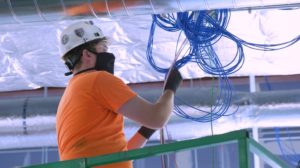03.09.2021
Root-Cause Analysis: A Vital Safety Tool
 As safety professionals, each day that goes by we face new challenges (or “opportunities” as our CEO would say) that stretch and pull us from many different directions. None of these are more difficult than when we receive a call informing us that one of our team members has had a serious incident or injury.
As safety professionals, each day that goes by we face new challenges (or “opportunities” as our CEO would say) that stretch and pull us from many different directions. None of these are more difficult than when we receive a call informing us that one of our team members has had a serious incident or injury.
After the call, how we respond could not be more critical in determining the extent of the damages. Performing a Root-Cause Analysis (RCA) is vital to determining what happened and to prevent it from happening again. Typically, an investigation team consisting of project management, superintendents and supervisors along with safety professionals review and secure the scene to collect information relevant to the incident.
As you begin an incident investigation and RCA, it is important to keep in mind that it must be done in a fear-free environment that focuses on the facts as they stand alone and must always avoid blame. The information collected must not gravitate around preconceived notions of employee error or misconduct.
Most safety incidents occur due to one of three causal factors:
- Human Error: This is the easiest and most identifiable cause. Determining how and why an employee made a mistake is typically the easiest part of an investigation. The investigation does not stop there, however; we must consider all the factors that allowed the employee to make the decision they did, and work to mitigate.
- Safety Systems: This requires a look at who oversees the actual hands-on process, who developed the process, how the employees are trained on the process and how the safety systems are implemented and used throughout a company.
- Culture: This is the most difficult part to look at for most employers. Culture is driven from the top down, everything from how processes and procedures are developed to how they are implemented, used and verified. Culture is absolutely a factor in what enables employees to make decisions that they make, whether positive or negative. What is the perceived acceptable level of risk? At some organizations, project budgets and schedules drive decisions about acceptable levels of risk. Will we have employees working from ladders or lifts? Do we bring in logistics personnel to handle and stage material or can we use the greenhorns (mostly inexperienced apprentices)? Is there enough heavy equipment to warrant a specialty contractor to move and set large electrical apparatus or generators? How many core holes are we going to have; should we bring in a specialty contractor for that process?
Steps 2 and 3 can be difficult, because they require that an organization takes a hard look in the mirror. But keeping an open mind and being willing to look just as hard at your safety systems and culture as you do the actions of employees enables you to develop effective safety systems and cultivate a positive safety culture, providing a defense against human error.
At Faith Technologies, RCA is one of the factors that has led to our strong safety culture. The secret to being successful at RCA is being passionate about it. If you possess a burning desire to protect the health and safety of your employees and to prevent future incidents, then you will succeed at doing so.
If you enjoyed this blog article, please subscribe to stay up to date on the latest industry news from our experts at Faith Technologies.




